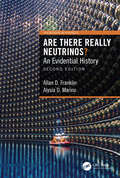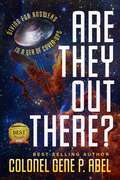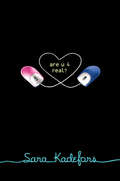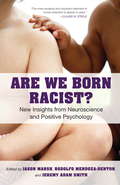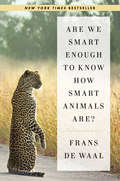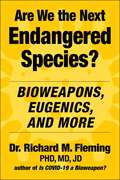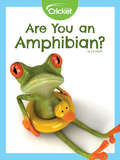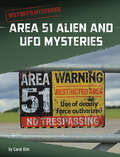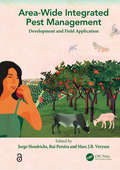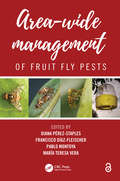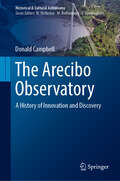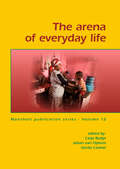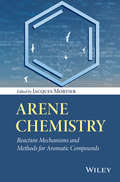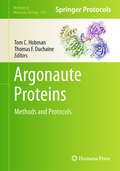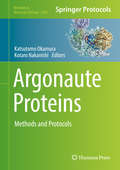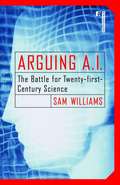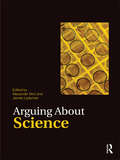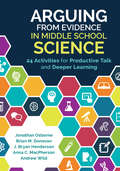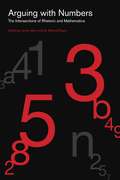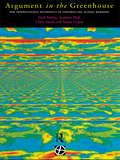- Table View
- List View
Are There Really Neutrinos?: An Evidential History (Frontiers in Physics)
by Allan D. Franklin Alysia D. MarinoThis intriguing and accessible book examines the experiments on neutrino oscillations. It argues that this history gives us good reason to believe in the existence of neutrinos, a particle that interacts so weakly with matter that its interaction length is measured in light years of lead. Yet, the scientific process has provided evidence of the elusive neutrino. Written in a style accessible to any reader with a college education in physics, Are There Really Neutrinos? is of interest to students and researchers alike. This second edition contains a new epilogue highlighting the new developments in neutrino physics over the past 20 years.
Are They Out There?: Diving for Answers In a Sea of Cover-Ups
by Gene P. Abel&“If you're ready to read a realistic approach to the possibility of alien life and whether we are visited by them, you will love Are They Out There? Diving for Answers In a Sea of Cover-Ups.&” – Readers&’ FavoriteNothing in the universe is unique and alone, and therefore in other regions there must be other earths inhabited by different tribes of men and different breeds of beast. - Titus Lucretius, De Rerum Natura circa 50BCE The question, Are They Out There? is not a new one. Since ancient times, humans have wondered about the potential of alien life. Between May 1, 2023, and June 1, 2024, alone, sightings of more than seven hundred unidentified aerial phenomena were reported-and twenty-one of these cases are still under investigation. They can't be explained by common objects. In Are They Out There? retired Colonel Gene P. Abel sifts through the accounts of military professionals and eyewitnesses alike in search of the truth about extra-terrestrial visitors. Discover what Colonel Abel has uncovered, and what the government might not be telling us, in this gripping new look at the history, and potential future impact, of UFOs, and alien contact. A newly released US report on unidentified flying objects says 143 sightings since 2004 remain unexplained. It does not rule out alien activity. - The New York Times, June 25, 2021
Are U 4 Real?
by Sara KadeforsKyla is exactly the kind of girl Alex could never talk to in real life. She's a gorgeous, outspoken L. A. girl who parties to forget about her absent father and depressed mother. He's a shy ballet dancer from outside San Francisco who's never been kissed. Luckily, when these sixteen-year-olds meet for the first time it's not in real life-it's in a chat room, where they can share their feelings of isolation and frustration away from the conformity-obsessed high school scene. Alex and Kyla quickly forge a friendship that's far from virtual- maybe they're even falling in love. But what happens when the soul mate you've never met moves from online to in person? Sara Kadefors's wildly romantic, award-winning Swedish bestseller perfectly captures the universal angst of being a teenager, and the perhaps even more universal struggle to negotiate identity in a multi-platform world.
Are We Being Watched?: The Search for Life in the Cosmos
by Paul MurdinAn engaging exploration with renowned astronomer Paul Murdin of how life emerged on Earth--and the possibilities that it exists elsewhere There is no more fascinating question than whether or not we are alone in a vast universe. Here, Paul Murdin applies the latest scientific discoveries and theories to inquire whether life exists on other planets and, if so, what forms it might take. Could there be somewhere life as advanced as here on Earth, or are we more likely to find primitive life-forms? Or are we the sole living organisms in a desolate and boundless cosmos? Professor Murdin invites us to join him in exploring an extraordinary array of evidence to determine if there is life elsewhere in the cosmos. He examines the case for life on Mars and Europa and asks whether on Enceladus or Titan we might find the "warm little" pond that Darwin speculated was where life began here on Earth. Describing the cosmic habitats that produce the alien worlds of our solar system and others, he examines the chances of finding life and the prospects for successful communication with an extraterrestrial intelligence.
Are We Born Racist?
by Jason Marsh Rodolfo Mendoza-Denton Jeremy A. SmithWhere do our prejudices come from? Why are some people more biased than others? Is it possible for individuals, and society as a whole, to truly defeat prejudice? In these pages, leading scientists, psychologists, educators, activists, and many others offer answers, drawing from new scientific discoveries that shed light on why and how our brains form prejudices, how racism hurts our health, steps we can take to mitigate prejudiced instincts, and what a post-prejudice society might actually look like. Bringing a diverse range of disciplines into conversation for the first time, Are We Born Racist? offers a straightforward overview of the new science of prejudice, and showcases the abundant practical, research-based steps that can be taken in all areas of our lives to overcome prejudice.
Are We Smart Enough to Know How Smart Animals Are?
by Frans de WaalA New York Times bestseller: "A passionate and convincing case for the sophistication of nonhuman minds." —Alison Gopnik, The Atlantic Hailed as a classic, Are We Smart Enough to Know How Smart Animals Are? explores the oddities and complexities of animal cognition—in crows, dolphins, parrots, sheep, wasps, bats, chimpanzees, and bonobos—to reveal how smart animals really are, and how we’ve underestimated their abilities for too long. Did you know that octopuses use coconut shells as tools, that elephants classify humans by gender and language, and that there is a young male chimpanzee at Kyoto University whose flash memory puts that of humans to shame? Fascinating, entertaining, and deeply informed, de Waal’s landmark work will convince you to rethink everything you thought you knew about animal—and human—intelligence.
Are We the Next Endangered Species?: Bioweapons, Eugenics, and More
by Dr. Richard M. FlemingAre We the Next Endangered Species? unravels the complex web of historical events, misinformation, and the ominous convergence of bioweapons and eugenics In this thought-provoking new book, Dr. Fleming challenges us to navigate the murky waters of history, exposing parallel programs developed over the last 170 years in the United States. This riveting exploration unearths ancient civilizations that embraced slavery, sterilization, and eugenics, drawing chilling parallels to our present reality. Dr. Fleming confronts the uncomfortable truth: are we repeating the mistakes of the past while expecting different outcomes? Are we destined to replicate the errors that led to the rise of powerful individuals and organizations seeking ultimate control over others? Key revelations include the stealthy usurpation of power in the United States since the 1850s, the nation's pivotal role in developing biological and chemical weapons, and its shocking collaboration with Nazi scientists, doctors, and intelligence officers. Dr. Fleming unveils the shadowy world of covert operations, the establishment of the military-industrial complex, and the surrender of medical control to the federal government. Readers will discover the intricate pathways of biowarfare and eugenics converging with the emergence of COVID. They will learn about the gain-of-function bioweapons responsible for the pandemic and the parallel development of eugenic genetic vaccines. Fleming reveals the control wielded by the military-industrial complex and world leaders over your life, movement, property, and freedoms. This book is not just an exploration of the past or a revelation of how those in power are on the brink of realizing their ultimate control, it's a call to action. It doesn't just raise awareness—it empowers readers to understand, question, and take decisive action to halt the ominous path we're on. In a world where truth is elusive and power is coveted, this book is a beacon of knowledge, urging you to discover what you can do to stop the impending threats to our existence. The future hangs in the balance and Are We the Next Endangered Species? provides the roadmap to safeguard it.
Are You an Amphibian?
by Liz HuyckFrogs and toads and newts, oh my! Amphibians are a special class of animals. Have you ever seen one? Learn what sets amphibians apart from reptiles, and then take a quiz to see if the animal of your choice makes the cut as an amphibian!
Area 51 Alien and UFO Mysteries (History's Mysteries)
by Carol KimA highly secure military base sits in the middle of the Nevada Desert. What happens inside is kept top secret. Many UFO sightings have been reported nearby. Some people even say alien bodies are stored there. What really goes on behind its highly guarded fences? Explore the theories and learn why Area 51 has become one of history’s greatest mysteries.
Area-wide Integrated Pest Management: Development and Field Application
by Jorge Hendrichs; Rui Pereira; Marc J.B. VreysenOver 98% of sprayed insecticides and 95% of herbicides reach a destination other than their target species, including non-target species, air, water and soil. The extensive reliance on insecticide use reduces biodiversity, contributes to pollinator decline, destroys habitat, and threatens endangered species. This book offers a more effective application of the Integrated Pest Management (IPM) approach, on an area-wide (AW) or population-wide (AW-IPM) basis, which aims at the management of the total population of a pest, involving a coordinated effort over often larger areas. For major livestock pests, vectors of human diseases and pests of high-value crops with low pest tolerance, there are compelling economic reasons for participating in AW-IPM. This new textbook attempts to address various fundamental components of AW-IPM, e.g. the importance of relevant problem-solving research, the need for planning and essential baseline data collection, the significance of integrating adequate tools for appropriate control strategies, and the value of pilot trials, etc. With chapters authored by 184 experts from more than 31 countries, the book includes many technical advances in the areas of genetics, molecular biology, microbiology, resistance management, and social sciences that facilitate the planning and implementing of area-wide strategies. The book is essential reading for the academic and applied research community as well as national and regional government plant and human/animal health authorities with responsibility for protecting plant and human/animal health.
Area-Wide Management of Fruit Fly Pests
by Pablo Montoya Diana Perez-Staples Francisco Diaz-Fleischer Maria Teresa VeraFruit fly (Diptera: Tephritidae) pests have a profound impact on horticultural production and economy of many countries. It is fundamental to understand their biology and evaluate methods for their suppression, containment, or eradication. Area-Wide Management of Fruit Fly Pests comprises contributions from scientists from around the world on several species of tephritids working on diverse subjects with a focus on area-wide management of these pests. The first three sections of the book explore aspects of the biology, ecology, physiology, behavior, taxonomy, and morphology of fruit flies. The next two sections provide evidence on the efficacy of attractants, risk assessment, quarantine, and post-harvest control methods. The fifth and sixth sections examine biological control methods such as the Sterile Insect Technique and the use of natural enemies of fruit flies. The seventh section focuses on area-wide integrated pest management and action programs. Finally, the eighth section examines social, economic, and policy issues of action programs aimed at involving the wider community in the control of these pests and facilitate the development of control programs. Features: Presents information on the biology of tephritid flies. Provides knowledge on the use of natural enemies of fruit flies for their biological control. Includes research results on models and diets used for the Sterile Insect Technique. Reports developments on the chemical ecology of fruit flies that contribute to make control methods more specific and efficient. Reviews subjects such as Holistic Pest Management and Area-Wide Management Programs including social, economic, and policy issues in various countries.
The Arecibo Observatory: A History of Innovation and Discovery (Historical & Cultural Astronomy)
by Donald CampbellWritten by its former Director, this book presents a historical account of the famous Arecibo Observatory and its 305-meter radio astronomical telescope, widely known for its groundbreaking scientific discoveries and starring role in the James Bond movie, Golden Eye.The story details the planning, funding and construction of the telescope; the people who masterminded and contributed to the project; and the involvement of the US Department of Defense in funding the construction. It also includes the seminal scientific achievements in the three research areas to which the telescope contributed, ionospheric physics, planetary science and radio astronomy.The book continues through later upgrades made to the site, showing how the Arecibo telescope has arguably remained the world’s most versatile and productive radio science instrument for over 50 years. This historical account will fascinate astronomers and historians of science, serving as a valuable contribution to the history of 20th century astronomy.
The arena of everyday life
by Carja Butijn Gerda Casimir Johan Van OphemIn 'The arena of everyday life' nine authors look back and forward at developments in the sociology of consumers and households. Nine chapters show variety in the employed methods, from multivariate analyses of survey data to classical essays. The contributions are organised around four themes. In the first theme, two chapters entail a critical discussion of the concepts livelihood and household. The second part deals with health, in particular food security, hygiene and aids/HIV. The third theme focuses on female opportunities to foster income procurement of household by respectively microfinance and entrepreneurship. The fourth theme concentrates on two topical societal developments in a Western society, the first chapter dealing with the issue of creating opportunities for tailor-made services to older people, the second one focussing on the home-work balance of telecommuters. This publication, written by international researchers, once supervised by prof. Anke Niehof, while writing their PhD dissertation, or (former) colleagues of Niehof, covers the many issues and reflecting her work and interest. The arena of everyday life is what her research and teaching evolved around, as shown in this book.
Arena of Monsters (Escape from Planet Alcatraz)
by Michael DahlZak Nine has been captured and placed in Planet Alcatraz's "Monster Zoo." But this isn't any ordinary zoo. This zoo holds dozens of alien "monsters" who are forced to fight for the entertainment of the prison planet's owners. Zak's friend, Erro, is determined to break into the zoo to rescue the human boy. Erro will need to rely on his Quom survival skills to succeed. Will he be able to find Zak, avoid the zoo's Overseers, and find a way out?
Arene Chemistry
by Jacques MortierOrganized to enable students and synthetic chemists to understand and expand on aromatic reactions covered in foundation courses, the book offers a thorough and accessible mechanistic explanation of aromatic reactions involving arene compounds. * Surveys methods used for preparing arene compounds and their transformations * Connects reactivity and methodology with mechanism * Helps readers apply aromatic reactions in a practical context by designing syntheses * Provides essential information about techniques used to determine reaction mechanisms
Argonaute Proteins: Methods and Protocols (Methods in Molecular Biology #725)
by Tom C. Hobman Thomas F. DuchaineWith the rapid proliferation of RNAi applications in basic and clinical sciences, the challenge has now become understanding how components of RNAi machinery function together in a regulated manner. Argonaute proteins are the central effectors of RNAi and are highly conserved among eukaryotes and some archaebacteria. These RNA-binding proteins use small guide RNAs to silence expression of genes at the mRNA and DNA levels. In Argonaute Proteins: Methods and Protocols, expert researchers in this burgeoning field provide detailed, up-to-date methods to study Argonaute protein functions and interactions in a wide variety of cell types ranging from yeast to mammalian systems, as well as in vitro. Written in the highly successful Methods in Molecular BiologyTM series format, chapters include brief introductions to their respective topics, lists of the necessary materials and reagents, step-by-step, readily reproducible laboratory protocols, and key tips on troubleshooting and avoiding known pitfalls. Practical and authoritative, Argonaute Proteins: Methods and Protocols serves as a vital reference for both experienced and novice scientists approaching the vast complexities of RNAi research.
Argonaute Proteins: Methods and Protocols (Methods in Molecular Biology #1680)
by Katsutomo Okamura Kotaro NakanishiThis volume covers methods that analyze various Argonaute proteins from a variety of organisms to help researchers better understand their properties ranging from a molecular level to an organismal level. The chapters in this book explore the following topics: identification and expression analysis of guide nucleic acids and their targets; analysis of biochemical properties of Argonautes; biological functions of Argonautes; and obtaining materials and setting up analysis platforms. Written in the highly successful Methods in Molecular Biology series format, chapters include introductions to their respective topics, lists of the necessary materials and reagents, step-by-step, readily reproducible laboratory protocols, and tips on troubleshooting and avoiding known pitfalls. Cutting-edge and authoritative, Argonaute Proteins: Methods and Protocols is a valuable resource for researchers and scientists looking to expand their knowledge of Argonaute proteins and their functions.
Arguing A.I.: The Battle for Twenty-first Century Science
by Sam WilliamsFew scientific topics since the theory of biological evolution have inspired as much controversy as artificial intelligence has. Even now, fifty years after the term first made its appearance in academic journals, many philosophers and more than a few prominent scientists and software programmers dismiss the pursuit of thinking machines as the modern-day equivalent of medieval alchemists' hunt for the philosopher's stone--a pursuit based more on faith than on skeptical inquiry. In Arguing A.I., journalist Sam Williams charts both the history of artificial intelligence from its scientific and philosophical roots and the history of the A.I. debate. He examines how and why the tenor of the debate has changed over the last half-decade in particular, as scientists are struggling to take into account the latest breakthroughs in computer science, information technology, and human biology. For every voice predicting machines like 2001's HAL within the next twenty to thirty years, others have emerged with more pessimistic forecasts. From artificial intelligence's pioneers John McCarthy and Marvin Minsky, to futurist authors Ray Kurzweil and Hans Moravec, to software architects Bill Joy and Jaron Lanier,Arguing A. I. introduces readers to the people participating in the current debate, both proponents and critics of A.I. who are changing the way computers "think" and the way we think about computers. Ultimately, Arguing A.I. is as much a history of thought as it is a history of science. Williams notes that many of the questions plaguing modern scientists and software programmers are the same questions that have concerned scientists and philosophers since time immemorial: What are the fundamental limitations of science and scientific inquiry? What is the nature of intelligence? And, most important, what does it really mean to be human?
Arguing About Science (Arguing About Philosophy)
by Alexander Bird James LadymanArguing About Science is an outstanding, engaging introduction to the essential topics in philosophy of science, edited by two leading experts in the field. This exciting and innovative anthology contains a selection of classic and contemporary readings that examine a broad range of issues, from classic problems such as scientific reasoning; causation; and scientific realism, to more recent topics such as science and race; forensic science; and the scientific status of medicine. The editors bring together some of the most influential contributions of famous philosophers in the field, including John Stuart Mill and Karl Popper, as well as more recent extracts from philosophers and scientists such as Ian Hacking, Stephen Jay Gould, Bas van Fraassen, Nancy Cartwright, and John Worrall. The anthology is organised into nine clear sections: science, non science and pseudo-science race, gender and science scientific reasoning scientific explanation laws and causation science and medicine probability and forensic science risk, uncertainty and science policy scientific realism and anti-realism. The articles chosen are clear, interesting, and free from unnecessary jargon. The editors provide lucid introductions to each section in which they provide an overview of the debate, as well as suggestions for further reading.
Arguing From Evidence in Middle School Science: 24 Activities for Productive Talk and Deeper Learning
by Brian M. Donovan Anna C. MacPherson Andrew J. Wild Jonathan Francis Osborne J. (Joseph) HendersonTeaching your students to think like scientists starts here! If you’ve ever struggled to help students make scientific arguments from evidence, this practical, easy-to-use activity book is for you! Give your students the critical scientific practice today′s science standards require. You’ll discover strategies and activities to effectively engage students in arguments about competing data sets, opposing scientific ideas, applying evidence to support specific claims, and more. 24 ready-to-implement activities drawn from the physical sciences, life sciences, and earth and space sciences help teachers to: Align lessons to the Next Generation Science Standards (NGSS) Engage students in the 8 NGSS science and engineering practices Establish rich, productive classroom discourse Facilitate reading and writing strategies that align to the Common Core State Standards Extend and employ argumentation and modeling strategies Clarify the difference between argumentation and explanation Includes assessment guidance and extension activities. Learn to teach the rational side of science the fun way with this simple and straightforward guide!
Arguing From Evidence in Middle School Science: 24 Activities for Productive Talk and Deeper Learning
by Brian M. Donovan Anna C. MacPherson Andrew J. Wild Jonathan Francis Osborne J. (Joseph) HendersonTeaching your students to think like scientists starts here! If you’ve ever struggled to help students make scientific arguments from evidence, this practical, easy-to-use activity book is for you! Give your students the critical scientific practice today′s science standards require. You’ll discover strategies and activities to effectively engage students in arguments about competing data sets, opposing scientific ideas, applying evidence to support specific claims, and more. 24 ready-to-implement activities drawn from the physical sciences, life sciences, and earth and space sciences help teachers to: Align lessons to the Next Generation Science Standards (NGSS) Engage students in the 8 NGSS science and engineering practices Establish rich, productive classroom discourse Facilitate reading and writing strategies that align to the Common Core State Standards Extend and employ argumentation and modeling strategies Clarify the difference between argumentation and explanation Includes assessment guidance and extension activities. Learn to teach the rational side of science the fun way with this simple and straightforward guide!
Arguing to Solve a Mystery
by Meghan Comstock Andrew Falk Emily Gibson Tessaly JenNIMAC-sourced textbook
Arguing with Numbers: The Intersections of Rhetoric and Mathematics (RSA Series in Transdisciplinary Rhetoric #16)
by James Wynn G. Mitchell ReyesAs discrete fields of inquiry, rhetoric and mathematics have long been considered antithetical to each other. That is, if mathematics explains or describes the phenomena it studies with certainty, persuasion is not needed. This volume calls into question the view that mathematics is free of rhetoric. Through nine studies of the intersections between these two disciplines, Arguing with Numbers shows that mathematics is in fact deeply rhetorical. Using rhetoric as a lens to analyze mathematically based arguments in public policy, political and economic theory, and even literature, the essays in this volume reveal how mathematics influences the values and beliefs with which we assess the world and make decisions and how our worldviews influence the kinds of mathematical instruments we construct and accept. In addition, contributors examine how concepts of rhetoric—such as analogy and visuality—have been employed in mathematical and scientific reasoning, including in the theorems of mathematical physicists and the geometrical diagramming of natural scientists. Challenging academic orthodoxy, these scholars reject a math-equals-truth reduction in favor of a more constructivist theory of mathematics as dynamic, evolving, and powerfully persuasive. By bringing these disparate lines of inquiry into conversation with one another, Arguing with Numbers provides inspiration to students, established scholars, and anyone inside or outside rhetorical studies who might be interested in exploring the intersections between the two disciplines.In addition to the editors, the contributors to this volume are Catherine Chaput, Crystal Broch Colombini, Nathan Crick, Michael Dreher, Jeanne Fahnestock, Andrew C. Jones, Joseph Little, and Edward Schiappa.
Arguing with Numbers: The Intersections of Rhetoric and Mathematics (RSA Series in Transdisciplinary Rhetoric)
by James Wynn G. Mitchell ReyesAs discrete fields of inquiry, rhetoric and mathematics have long been considered antithetical to each other. That is, if mathematics explains or describes the phenomena it studies with certainty, persuasion is not needed. This volume calls into question the view that mathematics is free of rhetoric. Through nine studies of the intersections between these two disciplines, Arguing with Numbers shows that mathematics is in fact deeply rhetorical. Using rhetoric as a lens to analyze mathematically based arguments in public policy, political and economic theory, and even literature, the essays in this volume reveal how mathematics influences the values and beliefs with which we assess the world and make decisions and how our worldviews influence the kinds of mathematical instruments we construct and accept. In addition, contributors examine how concepts of rhetoric—such as analogy and visuality—have been employed in mathematical and scientific reasoning, including in the theorems of mathematical physicists and the geometrical diagramming of natural scientists. Challenging academic orthodoxy, these scholars reject a math-equals-truth reduction in favor of a more constructivist theory of mathematics as dynamic, evolving, and powerfully persuasive. By bringing these disparate lines of inquiry into conversation with one another, Arguing with Numbers provides inspiration to students, established scholars, and anyone inside or outside rhetorical studies who might be interested in exploring the intersections between the two disciplines.In addition to the editors, the contributors to this volume are Catherine Chaput, Crystal Broch Colombini, Nathan Crick, Michael Dreher, Jeanne Fahnestock, Andrew C. Jones, Joseph Little, and Edward Schiappa.
Argument in the Greenhouse: The International Economics of Controlling Global Warming (Global Environmental Change Ser.)
by Sujata Gupta Stephen Hall Nick Mabey Clare SmithHow can greenhouse gases be controlled and reduced? Will it be in time? This book adds a significant new contribution to the crucial climate change/global warming debate. Incorporating the key political and legal considerations into `real world' applied economic analysis, the authors provide a unique focus on the wider political economy of the problem. All the key issues of controlling climate change (costs, timing and degree of stabilisation, ecological taxt reform, developing countries, and evolution of international agreements), are placed firmly within the current legal and political context, with state-of-the-art economic techniques introduced to analyse different policy proposals. Covering both the developing and developed world, this book identifies important new policies to foster effective agreements on eissions and prevent global warming - realistic policies, likely to receive support at both international and domestic levels. be in time? This book adds a significant new contribution to the crucial climate change/global warming debate. Incorporating the key political and legal considerations into 'real world' applied economic analysis, the book's authors provide a unique focus on the wider political economy of the problem. All the key issues of controlling climate change (costs, timing and degree of stabilisation, ecological tax reform, developing countries and evolution of international agreements), are placed firmly within the current legal and political economy context, with state-of-the-art economic techniques introduced to analyse different policy proposals. Covering both the developing and developed world, this book identifies important new policies to foster effective agreements on emmissions and prevent global warming - realistic policies which are likely to receive support at both international and domestic levels.
